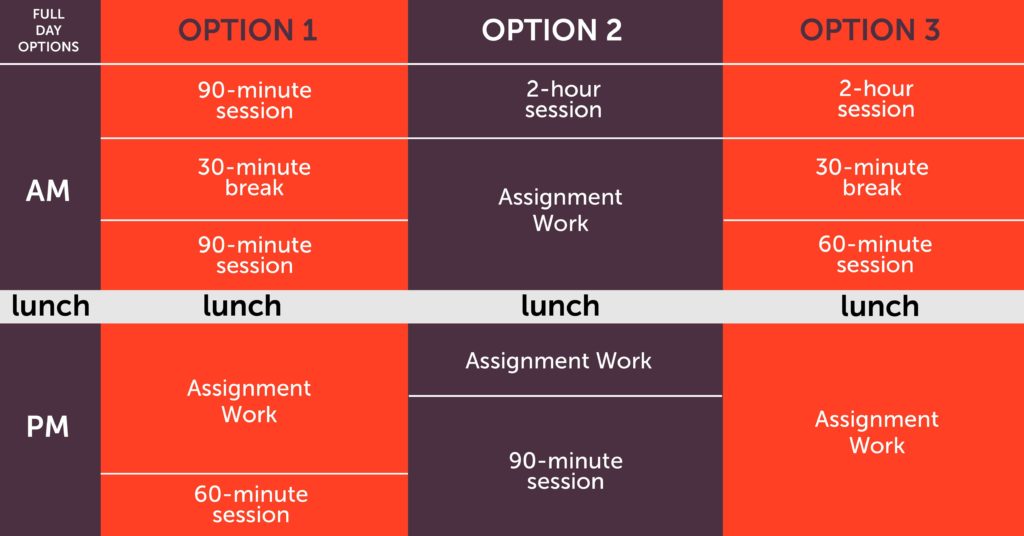Training is a lot like show business. A venue is chosen, the star of the show sometimes travels cross-country to perform, and crowds of people gather in anticipation. Regardless of what unexpected things might arise, whatever show has been planned still has to be staged for the patrons. The show must go on!
Live shows are fun, interactive, and engaging, often leaving the attendees wanting more.
Onsite training, executed well, should have a similar description and lasting effect.
[The Villain (COVID-19 global pandemic) enters stage right, twirling mustache – cue scary music.]
Because of the pandemic, onsite training may not be the best option right now. But as Freddy Mercury would say…”our smile still stays on.”
Since we’re shifting away from onsite training to online training right now, it’s time to shift our focus from Broadway to Hollywood. The training “scene” goes from an in-person stage show to a movie on the big screen. [Enter Online Training – stage left]
Online training must be engaging, but it doesn’t have to be packed with high-intensity entertainment to keep the audience’s attention, encourage thinking and have a good time.
The goal should be to balance high active elements such as co-presenters and co-hosts with low-active elements such as the chatbox and raise hand function. Be careful! Both low and high-active elements can lose their effectiveness if overused.
Here are a few ideas for low-active engagement (think comedians and opening acts):
1. Co-Presenters
Having a co-presenter who “shares the stage”, stimulates your audience’s senses. They’re hearing a new voice that has a different energy and tone and they’re seeing a new face with a different style and potentially different backgrounds.
2. Co-host
A co-host is different from a co-presenter or even a producer. They act more like an emcee for your training and are often used for comic relief. Maybe you have a self-proclaimed comedian among your staff or a trainer who likes to use their big personality to illustrate different points – they would both be a great fit as a co-host.
3. Video
Videos during your online training can take quite a few forms. You might interview someone live or show an animated video that demonstrates a part of your training material. Let your imagination run wild!
Our trainers love the following ideas for high active engagement (think car chases and parachute jumps):
1. Raise Hand Function
Raise your hand if…
Let people interact with the “show” and each other regarding the topic “at hand” (little pun there)… For example, raise your hand if you’ve had to deal with a difficult customer this week.
2. Video
One way to turn video from a low-active to a high-active interaction is to ask your trainees to take notes and talk it out afterward. This might look like putting people into randomly selected or preselected private theaters to discuss their notes and then having a representative of each group present their findings.
3. Chat Box
The chat box is great for asking open-ended questions such as:
- What’s the best thing you learned from this training?
- What will be the easiest to implement?
- What will be the most challenging?
- Where can I get a bucket of popcorn?
4. Scavenger Hunt
This might be the most creative of the high-active engagement activities listed here. This is where you ask your audience to leave their desk to go find something you’ve challenged them to find that is relevant to the training topic. Have fun with it!
Just like a playwright, the trainer gets to make decisions on structure and timing. If you have your trainees for the whole day, make sure you’re breaking things down into scenes and acts, grouping like content together and frontloading the most important content. 90 minutes is the average recommended time per scene so that people don’t lose focus.
Always remember intermission! A break for lunch and 30-minute breaks are easy to plan and often needed when training online. It gives people time to grab a drink, watch the next episode in their favorite series, or take their dog for a walk. Taking regular breaks and spacing out learning is good for retention and comprehension.
Here’s an example of how you could set up a full day of online training:

Assignment work gives your audience a chance to practice, discuss, and present on the topics they’re learning about. Get them out of their seats and up on the stage. These activities should be fun, relevant, and interactive. The more fun it is, the more memorable it will be.
You might ask your audience to:
- Act out a common scenario
- Play a game
- Perform a monologue
Pave the way for fun during your online training by considering housekeeping items in advance and being clear about your expectations. Here are some things to think about:
- How will people ask questions?
- Will trainee and trainer audio/video be on or off?
- How will you handle common distractions such as trainees checking their email or eating during the training?
- Are we having fun yet?
- Will there be a sequel?
Moving onsite training online is mission possible. It’s more than possible…it can be equally effective and fantastic fun for your team. On with the show!
If you’re reading through this and it seems like too big a production to handle on your own, Bonfire Training is here to help. Contact us today to start a conversation.
Additional Resources:
- Light a fire in your team! We offer many different types of training and can help you find the right one for your organization.
- Our Online OnDemand customer service training seminars are here to help get your team up and running from wherever you are!
- Employee engagement, emerging leaders, and improved customer experience. Contact us today!
- Live remote training can offer your organization what they need to grow and develop wherever you are!

